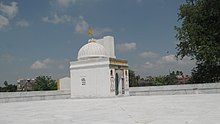Sthulabhadra
Acharya Sthulabhadra Suri | |
|---|---|
 Sthulabhadra Jain temple in Kamaldah, Patna | |
| Preceded by | Acharya Bhadrabahusuri |
| Succeeded by | Acharya Mahagirisuri and Acharya Suhastinsuri |
| Personal | |
| Religion | Jainism |
| Parent |
|
| Sect | Śvetāmbara |
| Religious career | |
| Teacher | Acharya Sambhutavijayasuri |
| Part of a series on |
| Jainism |
|---|
 |
|
| Philosophy
|
| Ethics Ethics of Jainism
|
| Jain prayers |
| Major figures
|
| Major sects |
| Festivals |
| Pilgrimages |
|
|

Sthulabhadra (297-198 BCE) was a Jain monk who lived during the 3rd or 4th century BC. He was a disciple of Bhadrabahu and Sambhutavijaya. His father was Sakatala, a minister in Nanda kingdom before the arrival of Chandragupta Maurya. When his brother became the chief minister of the kingdom, Sthulabhadra became a Jain monk and suceeded Bhadrabahu in the Pattavali as per the writings of the Kalpa Sūtra.[1] He is mentioned in the 12th-century Jain text Parisistaparvan (appendix to the Trisasti-shalakapurusa-caritra) by Hemachandra. [2]
Life
Sthulabhadra was a son of the Dhana Nanda's minister Sakatala and brother of Shrikaya.[3][4] He is traditionally dated in 297 to 198 BCE.[3] He loved and lived with a royal dancer in Dhana Nanda's court named Rupkosa.[3][4] He denied ministry after the death of his father and became a Jain monk.[5] His brother became the chief minister in Nanda empire later.[6][4] He became a disciple of Sambhutavijaya (347-257 BCE) and Bhadrabahu (322-243 BCE).[7][4][8] He led an ascetic life for 12 years.[6]

He spent his chaturmas at Rupkosa's home, during which she tried to lure him away from ascetic life but failed.[6] Sthulabhadra in turn gave her vows of a Shravika (Jain laywoman).[6]
He is said to have learned only 10 purvas (pre-canons with meanings) from Bhadrabahu. Although he knew the last 4 purvas as well, but since he did not know the meaning associated with them, he is not considered to have been a Shrutakevalin.[2] He was succeeded by his disciples Acharya Mahagirisuri and Acharya Suhastinsuri, whom he taught only 10 purvas because Bhadrabahu had imposed a condition upon him that he would not teach the last 4 purvas to anyone because he had used the knowledge of purvas to display magical powers.[2][6][9] 10th century Digambara texts state that Sthulabhadra permitted the use loincloth during the 12-year famine, a practice that started the Śvetāmbara order, but is considered as baseless according to followers of the Śvetāmbara sect. Avashyak Bhashya, a 5th century Śvetāmbara text written by Jinabhadra claims that the Śvetāmbara sect had always existed and that the Digambara sect was created by a rebellious monk named Sivabhuti. [10][11][12]
Legacy
Śvetāmbaras venerate Acharya Sthulabhadrasuri in the following hymn:[13]
मंगलं भगवान वीरो, मंगलं गौतम प्रभु। मंगलं स्थूलिभद्राद्या, जैन धर्मोस्तु मंगलं।।
Translated as:
Mangalam Bhagaväna Viro, mangalam Gautama prabhu, Mangalam Sthülibhadrädyä, Jaina dharmostu mangalam.
Meaning:
Bhagawän Mahävir is auspicious, Ganadhar Gautam Swämi is auspicious; Ächärya Sthulibhadra is auspicious, Jain religion is auspicious.
References
Citations
- ^ "Jaina Sutras, Part I (SBE22): Lives of the Ginas: List of the Sthaviras". sacred-texts.com. Retrieved 4 April 2024.
- ^ a b c Hemacandra. H. Jacobi, ed. (1891). Parishishtaparvam, 2nd ed. Calcutta. Verse IX, pp. 55–76.
- ^ a b c Natubhai Shah 2004, p. 42.
- ^ a b c d Hemacandra 1998, pp. 155, 169, 194–200.
- ^ Upinder Singh 2016, p. 273.
- ^ a b c d e Natubhai Shah 2004, p. 43.
- ^ Natubhai Shah 2004, pp. 42–43.
- ^ Arya Sthulibhadra By Vijaya Nityānanda Sūri, Cidānanda Vijaya
- ^ Jain Dharma ka Maulik Itihas, Acharya Hastimal, 1974, Part 2, p. 383-440
- ^ Dundas, Paul (2 September 2003). The Jains. Routledge. ISBN 978-1-134-50165-6.
- ^ "Digambara", britannica.com
- ^ Sthulabhadra, Ganesh Lalwani, Jain Journal, April 1985, p. 152
- ^ "YJA | Prayers". www.yja.org. Retrieved 4 April 2024.
Sources
- Hemacandra (1998), The Lives of the Jain Elders, translated by Fynes, Richard, Oxford University Press, ISBN 978-0-19-283227-6
- Shah, Natubhai (2004) [First published in 1998], Jainism: The World of Conquerors, vol. I, Motilal Banarsidass, ISBN 978-81-208-1938-2
- Singh, Upinder (2016), A History of Ancient and Early Medieval India: From the Stone Age to the 12th Century, Pearson PLC, ISBN 978-81-317-1677-9
 | This Jainism-related article is a stub. You can help Wikipedia by expanding it. |
- v
- t
- e
 | This biography of an Indian religious figure is a stub. You can help Wikipedia by expanding it. |
- v
- t
- e














